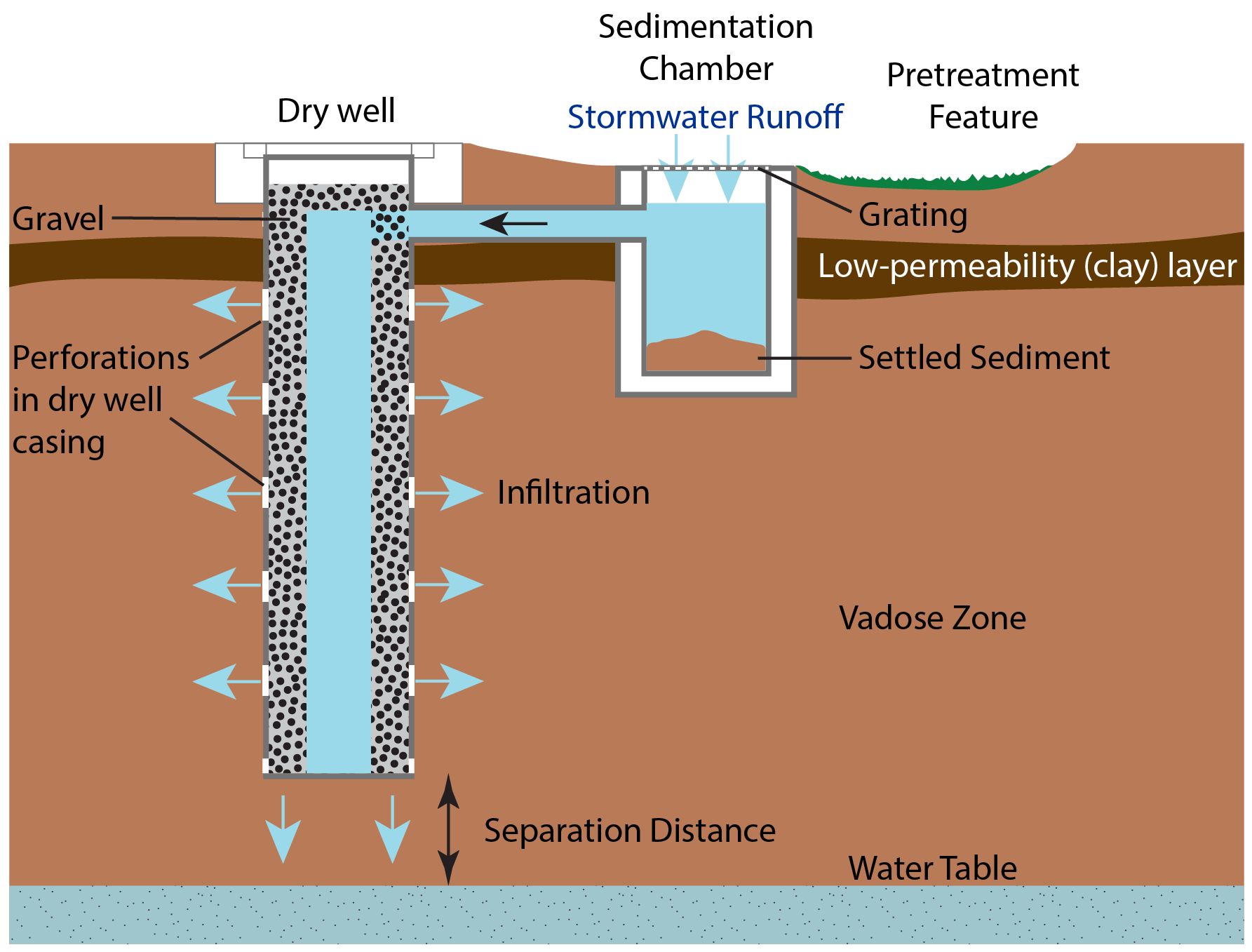Wells used to drain stormwater and recharge groundwater supplies
What is a Dry Well?
A dry well is a well that is used to transmit surface water underground and is deeper than its width at the surface (see image, below). Most dry wells are 30 to 70 feet deep and 3 feet wide at the surface. They are lined with perforated casings and can be filled with gravel or rock or left empty. Today, dry wells usually include some form of pretreatment to remove oil, particles, and associated contaminants, reducing the risk of clogging the wells and of transporting contaminants underground.
Typical dry well design with pretreatment features (not to scale). Arrows indicate the flow of stormwater through the dry well system and into the surrounding sediment and rock. Image Credit: E. Edwards and B. Mandler
Environmental and Human Benefits
Dry wells can be used to reduce the adverse effects of stormwater runoff on streams and rivers. Capturing urban stormwater prevents the runoff from entering streams and lakes where contaminants could cause pollution and erosion could damage aquatic habitats. Dry wells can also be used to return water to aquifers: a single dry well can transmit up to 5 acre-feet of water per year to underlying aquifers, equivalent to the water needs of about 10 households. This ability to recharge local groundwater supplies can help increase water resource security by mitigating the effects of drought or excessive groundwater extraction.
Risks to Groundwater Quality
Dry well use has been limited in some places by the concern that dry wells could contaminate groundwater, including drinking water, by reducing the distance contaminated stormwater must travel through sediment in order to reach groundwater. Surface soil and underground sediment remove contaminants by acting as a natural filter, but dry wells allow stormwater contaminants to bypass many underground layers. Groundwater contamination has occurred in the past when surface contaminant spills have entered dry wells, or when substances have been illegally dumped into open dry well. However, groundwater contamination is rare when dry wells are used as intended and when appropriate precautions are taken. Contamination risk can be reduced by using dry wells at sites where spills are unlikely or installing emergency shut-off valves to keep out contaminated water.
Dry wells can be a safe and effective way to manage stormwater and recharge groundwater as long as:
- The stormwater is not contaminated
- Appropriate pretreatment is used
- The dry wells are installed in suitable locations
A vegetated pretreatment feature (grassy swale) with dry well in center. Image Credit: California Office of Environmental Health Hazard Assessment
Avoiding Risks Associated with Dry Wells
Appropriate pretreatment design. Efficient pretreatment is the key to keeping contaminants out of groundwater. Vegetation helps to trap sediment and associated contaminants (see image, bottom-left). Sedimentation chambers further remove contaminants by allowing sediment to settle out of stormwater.
Safe dry well siting. Some states provide guidelines for where to install dry wells as part of their permitting process. These guidelines include minimum vertical separation distances between the dry well and groundwater, horizontal separation from municipal wells, the amount of pretreatment required, and appropriate land use surrounding a potential dry well. Typically, 10 feet of vertical separation is required between the dry well bottom and the water table, and a vadose zone of sand/gravel and clay is ideal for removing contaminants while still allowing aquifer recharge. Contaminant-rich areas, such as gas stations and many industrial sites, are often unsuitable for dry well installation.
Stormwater quality monitoring. For any new dry well installation, it is important to monitor the composition of stormwater entering the well over several years to identify potential risks to groundwater. Stormwater entering the well may be analyzed for common urban contaminants (metals, combustion by-products (PAHs), pesticides/herbicides, and volatile organics) and water soluble pollutants (e.g., nitrate and neonicitonoids).
Quick facts
- Dry wells have been used around the world for decades. They are used in Australia, Europe (e.g. UK and France), Asia (e.g. Japan and India), and the US.
- Dry wells are also known as soakaways, soakwells, and soak pits.
- The majority of U.S. states oversee their own dry well programs; the rest are regulated directly by the EPA.
- States with large dry well programs (number of dry wells in state):
- Washington: 100,000
- Arizona: 52,000
- Oregon: 46,000
- California: 35,000
Key concepts, defined
Aquifer - coarse gravel or rock that contains and/or transmits groundwater.
PAH - polycyclic aromatic hydrocarbons, a group of carcinogenic molecules commonly formed by burning wood and other matter.
Water table - the depth underground below which rocks are saturated with (ground)water
Vadose zone - the area below the land surface but above the water table - this region conducts but is not saturated with water
More Resources
Stormwater Drainage Wells, Environmental Protection Agency
Class V Underground Injection Control Study, Environmental Protection Agency
Dry Well Usage Across the United States, American Geosciences Institute
Managed Aquifer Recharge, American Geosciences Institute
References
Aquifer Protection Program Permits, Arizona Department of Environmental Quality
Drywell Database, Arizona Department of Environmental Quality
Elk Grove Dry Well Project, City of Elk Grove, California
Underground Injection Control (UIC) Program, City of Portland (Oregon) Bureau of Environmental Services
The Class V Underground Injection Control Study, Vol. 3, Stormwater Drainage Wells, Environmental Protection Agency
Hydrogeology, Water Chemistry, and Factors Affecting the Transport of Contaminants in the Zone of Contribution of a Public-Supply Well in Modesto, Eastern San Joaquin Valley, California, U.S. Geological Survey
The Los Angeles and San Gabriel Rivers Water Augmentation Study, Los Angeles and San Gabriel Rivers Watershed Council
Rule Authorized Injection Systems, Oregon Department of Environmental Quality
Underground Injection Control (UIC) Database, Oregon Department of Environmental Quality
Estimation of Groundwater Recharge from Precipitation, Runoff into Drywells, and on-Site Waste-Disposal Systems in the Portland Basin, Oregon and Washington, U.S. Geological Survey
MaxWell IV Drainage System: Product Information and Design Features, Torrent Resources (detailed example of a dry well design)
Guidance for UIC Wells that Manage Stormwater, Washington State Department of Ecology

This work is licensed under a Creative Commons Attribution-NonCommercial-NoDerivatives 4.0 International License.
You are free to share or distribute this material for non-commercial purposes as long as it retains this licensing information, and attribution is given to the American Geosciences Institute.




